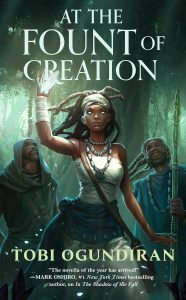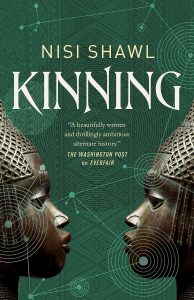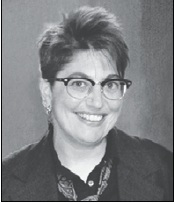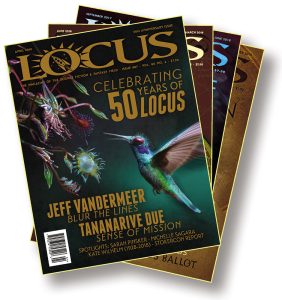The Year in Review 2024 by Gary K. Wolfe

2024: Descent (or Ascent) into Multiplicity
It’s a bit bracing to be reminded that I’ve been writing these yearly review columns for more than three decades, but it does put things in perspective. Some of the books mentioned in those first couple of columns, of course, are barely remembered now, but others still seem to be a significant part of the discussion – Connie Willis’s Doomsday Book, Neal Stephenson’s Snow Crash, Geoff Ryman’s Was, Kim Stanley Robinson’s Red Mars, major novels from Greg Bear, Joe Haldeman, and Ian McDonald – and it inevitably raises the question, now that we’re almost a quarter of the way through the no-longer-new century, of which books from 2024 might still be in the mix in the 2050s. What were this year’s enduring classics?
 Sorry, but I’m not about to fall into that trap. For one thing, there are some things time can do that critics can’t. For another, the SFF field was so much less diverse in so many ways in the 1990s that the old discussion now seems pretty insular and – well, pretty old. Not only are there far more voices in the discussion these days, but there are multiple discussions among multiple communities. Fantasy has assumed a much more prominent role in the market, while traditional hard SF seems to have receded. (It may have partly been the luck of the draw, but I read over twice as many fantasy as SF novels this year.) “Romantasy,” if it existed back then, wasn’t even close to getting that label, and even “urban fantasy” (according to Stefan Ekman’s recent study) was a term mostly applied to things like The Wiz. SFF from outside the usual Anglo-American-Australian-Canadian axis was comparatively uncommon, and stories set in other parts of the world were only slightly less so. By this past year, it didn’t seem unusual to see fiction from or about Nigeria, Vietnam, Sri Lanka, the Caribbean, Korea, Mexico, India, or elsewhere. Back then, when gods showed up in fantasy novels, they were most likely to be Greek or Norse; these days, they’re almost as likely to be Yoruba Orisha, as in Tobi Ogundiran’s Guardian of the Gods diptych, which got off to a rousing start with In the Shadow of the Fall and concluded this year with At the Fount of Creation.
Sorry, but I’m not about to fall into that trap. For one thing, there are some things time can do that critics can’t. For another, the SFF field was so much less diverse in so many ways in the 1990s that the old discussion now seems pretty insular and – well, pretty old. Not only are there far more voices in the discussion these days, but there are multiple discussions among multiple communities. Fantasy has assumed a much more prominent role in the market, while traditional hard SF seems to have receded. (It may have partly been the luck of the draw, but I read over twice as many fantasy as SF novels this year.) “Romantasy,” if it existed back then, wasn’t even close to getting that label, and even “urban fantasy” (according to Stefan Ekman’s recent study) was a term mostly applied to things like The Wiz. SFF from outside the usual Anglo-American-Australian-Canadian axis was comparatively uncommon, and stories set in other parts of the world were only slightly less so. By this past year, it didn’t seem unusual to see fiction from or about Nigeria, Vietnam, Sri Lanka, the Caribbean, Korea, Mexico, India, or elsewhere. Back then, when gods showed up in fantasy novels, they were most likely to be Greek or Norse; these days, they’re almost as likely to be Yoruba Orisha, as in Tobi Ogundiran’s Guardian of the Gods diptych, which got off to a rousing start with In the Shadow of the Fall and concluded this year with At the Fount of Creation.
 Of the relatively paltry amount of SF I saw this year, the most ambitious – both philosophically and structurally – was Adam Roberts’s Lake of Darkness, a sort of existential serial-killer murder mystery space opera embedded in a shrewd critique of both space opera and utopianism. Ray Nayler continued his interest in exploring nonhuman intelligence (or at least nonhuman perception) with the provocative The Tusks of Extinction, this time considering what it’s like to be a mammoth (rather than an octopus, as in his previous novel Mountain in the Sea). Nisi Shawl’s Kinning was a surprising sequel to her 2016 Everfair, which described a safe-haven state carved out of the former Belgian Congo. Kinning is more intimate in scale, and presents a sort of pharmaceutical utopia involving an empathy drug – but without ignoring the racism and capitalism that fueled the first novel. Nnedi Okorafor’s She Who Knows was a prequel to her World Fantasy Award-winning Who Fears Death, focusing on the earlier life of the mother of Onyesonwu from that earlier novel; it’s supposedly the first of a series of novellas returning us to the world of that novel. Vajra Chandrasekera’s second novel, Rakesfall, was a far more experimental followup to his earlier The Saint of Bright Doors, and was not the only novel of the year to test the boundaries between SF and fantasy. Of the SF novellas I read, Sofia Samatar’s The Practice, the Horizon, and the Chain was the most provocative – a kind of academic novel set aboard a rigorously stratified generation ship – while Izzy Wasserstein’s These Fragile Graces presents a trans woman seeking community in a grim but compelling future Kansas City. Suyi Davies Okungbowa’s Lost Ark Dreaming was among the more effective climate-disaster novellas, as well as a sharp critique of another rigidly stratified society, this time in a densely populated mega-high-rise building.
Of the relatively paltry amount of SF I saw this year, the most ambitious – both philosophically and structurally – was Adam Roberts’s Lake of Darkness, a sort of existential serial-killer murder mystery space opera embedded in a shrewd critique of both space opera and utopianism. Ray Nayler continued his interest in exploring nonhuman intelligence (or at least nonhuman perception) with the provocative The Tusks of Extinction, this time considering what it’s like to be a mammoth (rather than an octopus, as in his previous novel Mountain in the Sea). Nisi Shawl’s Kinning was a surprising sequel to her 2016 Everfair, which described a safe-haven state carved out of the former Belgian Congo. Kinning is more intimate in scale, and presents a sort of pharmaceutical utopia involving an empathy drug – but without ignoring the racism and capitalism that fueled the first novel. Nnedi Okorafor’s She Who Knows was a prequel to her World Fantasy Award-winning Who Fears Death, focusing on the earlier life of the mother of Onyesonwu from that earlier novel; it’s supposedly the first of a series of novellas returning us to the world of that novel. Vajra Chandrasekera’s second novel, Rakesfall, was a far more experimental followup to his earlier The Saint of Bright Doors, and was not the only novel of the year to test the boundaries between SF and fantasy. Of the SF novellas I read, Sofia Samatar’s The Practice, the Horizon, and the Chain was the most provocative – a kind of academic novel set aboard a rigorously stratified generation ship – while Izzy Wasserstein’s These Fragile Graces presents a trans woman seeking community in a grim but compelling future Kansas City. Suyi Davies Okungbowa’s Lost Ark Dreaming was among the more effective climate-disaster novellas, as well as a sharp critique of another rigidly stratified society, this time in a densely populated mega-high-rise building.
The year in fantasy was characterized by a number of fairly high-profile novels by some major figures in the field. One of the most widely anticipated, Kelly Link’s first novel The Book of Love, appeared early in the year to some glowing reviews, though some readers seemed daunted by its 640-page length and its focus not on the sort of sweeping epic such length usually portends, but on a limited number of characters in a small town – which nevertheless becomes the focus of cosmic struggles. My argument remains that the key to the novel really lies in its title, despite one of the more terrifying villains of the year. A novel of equally daunting weight, and equally surprising rewards, was Lev Grossman’s revisionist Arthurian saga The Bright Sword, which perhaps wisely dispatched Arthur before the action even begins, focusing instead on the surviving knights seeking their role in the world. Without doing a systematic count, it seems that the Link and Grossman novels have shown up most often on mainstream “best of the year” lists (Time, The New York Times, etc.).
Peter Beagle returned to more or less familiar territory with I’m Afraid You’ve Got Dragons, which is a bit darker than the whimsical title suggests, in terms of both character development and the deployment of magic. Nalo Hopkinson’s Blackheart Man explored themes of colonialism and personal responsibility, set in a vividly realized imaginary Caribbean nation, in a manner that evokes the best of her earlier work. Alan Moore inaugurated a new series of “hidden London” novels with The Great When, which is both energetic and good-natured even as it breaks little new ground. And Paolo Bacigalupi, shifting from SF into historical fantasy, revisits another familiar space – an alternate version of early-Renaissance Italy – with Navola, the beginning of an epic series that makes full use of the colorful setting as well as the violence and betrayals endemic to the form, and that takes a surprisingly dark turn in setting up the next volume. Ian McDonald took an unusual but effective turn into folk horror with the novella The Wilding, which combined elements of social satire with a chilling tale of malevolent nature spirits. Nghi Vo had two major titles, The Brides of High Hill, which took her ongoing “Singing Hills” series of novellas into full Gothic mode, and The City in Glass, which may suggest a few familiar antecedents in its tale of an unlikely partnership between a demon and an angel, but turns into very much its own tale, a powerful fable of the reconstruction of a destroyed city. And Kate Heartfield, who has emerged rather quickly as one of Canada’s leading fantasists, combined art history, World War II espionage, and a family gifted with second sight in The Tapestry of Time. Among debut novels, two struck me as outstanding. Samantha Mills’s The Wings Upon Her Back is an almost operatic tale of disillusionment and redemption, while Minsoo Kang’s The Melancholy of Untold History, an ambitious and deeply thoughtful meditation on history, storytelling, and myth.
Last year I noted a resurgence of haunted house stories in novels by Elizabeth Hand, T. Kingfisher, and Alix E. Harrow, and the trend seemed unabated in 2024 (is this focus on interiors partly an aftereffect of hiding out during the pandemic?). Perhaps the most ambitious, in a literary sense, was Rivers Solomon’s Model Home, in which a Black family in an upscale suburb of Dallas contends with forces that may partly be supernatural, but certainly seem to have their roots in real family and social tensions. Sarah Pinsker’s Haunt Sweet Home ingeniously played with familiar tropes in what is essentially a dead-on parody of those “psychic investigators” reality-TV shows, while Christopher Barzak’s A Voice Calling, narrated by the whole town, describes generations of suspicious doings among families who have occupied a local house. Both Premee Mohamed’s The Butcher of the Forest and Lee Mandelo’s The Woods All Black are pretty chilling explorations of that haunted-house adjacent theme, the haunted woods, as is the Ian McDonald novella mentioned above.
Major story collections included Wole Talabi’s Convergence Problems, a stellar and varied selection which reminded readers of his roots in science fiction after the success of his fantasy novel Shigidi and The Brass Head of Obalufon, and Ann Leckie’s Lake of Souls: The Collected Short Fiction, which also was a demonstration of range, featuring tales from her Imperial Radch and Raven Tower worlds as well as several independent selections. Nalo Hopkinson’s Jamaica Ginger and Other Concoctions also demonstrated a variety of tale-types, including the title story, a collaboration with Nisi Shawl. Smaller collections include two more volumes in PM Press’s always stimulating “Outspoken Authors” series, edited for years by the late Terry Bisson, John Kessel’s The Presidential Papers and Jonathan Lethem’s The Collapsing Frontier. Bisson’s own collection of his long-running “This Month in History” Locus columns served as a witty commentary on SF clichés and conventions, while reminding us of what we lost with Terry’s death. A couple of retrospective collections of historically important authors were Harlan Ellison’s Greatest Hits, which – exactly as the title says – presented Ellison’s most famous (and most familiar) stories, while Logical Fantasy: The Many Worlds of John Wyndham presents a wide variety of tales that will likely surprise readers familiar with Wyndham’s long career only on the basis of a couple of famous novels.
The best reprint anthology I saw was Jonathan Strahan’s New Adventures in Space Opera, continuing and updating Strahan’s ongoing interest in exploring the varieties of New Space Opera. Hugh Howey’s guest-editing stint with John Joseph Adams produced one of the stronger Best American Science Fiction and Fantasy volumes of recent years. J. Michael Stracynski’s The Last Dangerous Visions was listed as edited by Harlan Ellison, even though Ellison chose fewer than half the stories and some were commissioned specifically for the volume, with mixed results.
I didn’t see a lot of non-fiction, but the most important academic study was Stefan Ekman’s Urban Fantasy, which makes a fascinating and largely persuasive case that this is a genre of its own, and not a subset of fantasy. Of single-author studies (or actually, single-book studies), Paul Kincaid’s Keith Roberts’s Pavane: A Critical Companion was an illuminating discussion of a classic but often overlooked novel. In fandom studies, or perhaps fandom nostalgia, The Visual History of Science Fiction Fandom, Volume Three: 1941, edited by David Ritter, Daniel Ritter, Sam McDonald, and John L. Coker III, continued this series’ opulent volumes of reproductions of fan ephemera, this time focusing on only a single year prior to U.S. entry into World War II. A book not specifically about SF, but with clear implications for researchers and collection and with several SFF examples, was John Clute’s The Book Blinders: Annals of Vandalism at the British Library: A Necrology was also a beautifully produced volume meant to show us what is lost when libraries discard book dustjackets.
Given such a variety of books, it’s fair to say that the entire SFF field seems a bit chaotic compared to those lists from three decades ago, but that’s not necessarily a bad thing. More than a century ago, Henry Adams saw the entire young 20th century as a sort of shift from unity into multiplicity, from a confident sense that, for example, everyone knew what a good novel was (though he wasn’t specifically talking about novels) to a world in which the very notion of a novel would be tested. A quarter of the way into the 21st century, SFF seems to be moving in much the same direction, which could be seen as fragmentation, or simply a shift toward multiplicity. There are still plenty of Tolkienian fantasies, woolly space operas, and off-the-shelf dystopias featuring angry teens, but they no longer seem to be the defining centers of the field, and I’m not sure there is one. I said a few years ago in this space that no one owns SF anymore, and that’s even more true now. Who’s to complain?
Gary K. Wolfe is Emeritus Professor of Humanities at Roosevelt University and a reviewer for Locus magazine since 1991. His reviews have been collected in Soundings (BSFA Award 2006; Hugo nominee), Bearings (Hugo nominee 2011), and Sightings (2011), and his Evaporating Genres: Essays on Fantastic Literature (Wesleyan) received the Locus Award in 2012. Earlier books include The Known and the Unknown: The Iconography of Science Fiction (Eaton Award, 1981), Harlan Ellison: The Edge of Forever (with Ellen Weil, 2002), and David Lindsay (1982). For the Library of America, he edited American Science Fiction: Nine Classic Novels of the 1950s in 2012, with a similar set for the 1960s forthcoming. He has received the Pilgrim Award from the Science Fiction Research Association, the Distinguished Scholarship Award from the International Association for the Fantastic in the Arts, and a Special World Fantasy Award for criticism. His 24-lecture series How Great Science Fiction Works appeared from The Great Courses in 2016. He has received six Hugo nominations, two for his reviews collections and four for The Coode Street Podcast, which he has co-hosted with Jonathan Strahan for more than 300 episodes. He lives in Chicago.
This review and more like it in the February 2025 issue of Locus.
 While you are here, please take a moment to support Locus with a one-time or recurring donation. We rely on reader donations to keep the magazine and site going, and would like to keep the site paywall free, but WE NEED YOUR FINANCIAL SUPPORT to continue quality coverage of the science fiction and fantasy field.
While you are here, please take a moment to support Locus with a one-time or recurring donation. We rely on reader donations to keep the magazine and site going, and would like to keep the site paywall free, but WE NEED YOUR FINANCIAL SUPPORT to continue quality coverage of the science fiction and fantasy field.
©Locus Magazine. Copyrighted material may not be republished without permission of LSFF.







